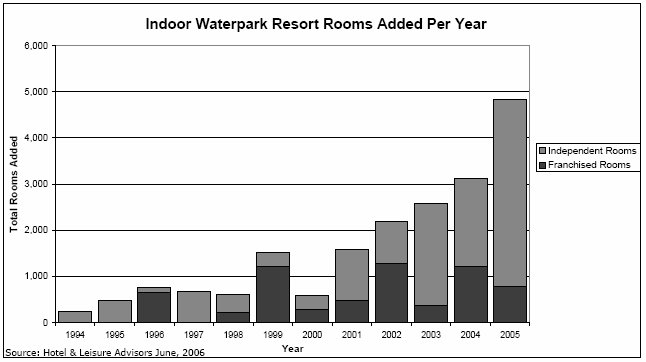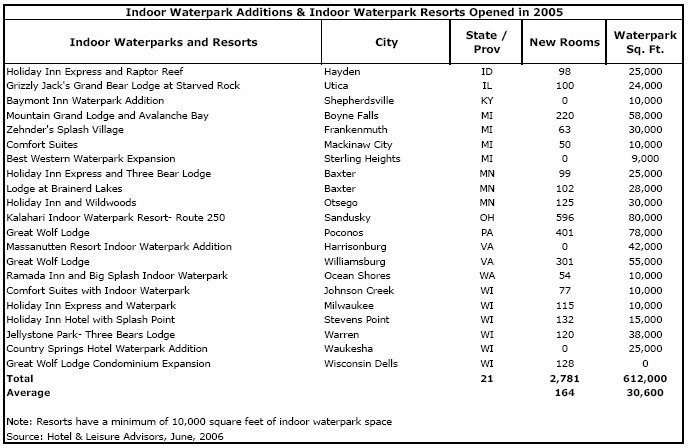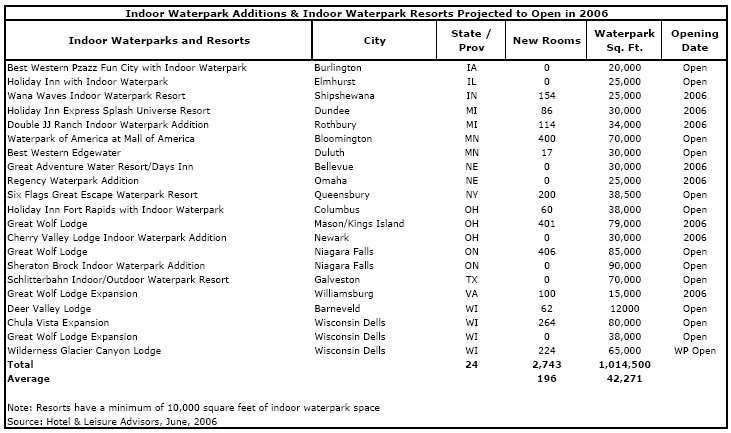advertisement
..
|
|
|
Numbers Increase in �06 By: David J. Sangree, MAI, CPA, ISHC, August 2006 Indoor waterpark resorts have established themselves as a viable segment
of the travel industry and expanded well beyond their Wisconsin base. During
the period from 1994 to 2005, 80 indoor waterpark resorts opened or expanded
their properties in the U.S. and Canada totaling approximately 2,208,000
square feet and offering over 19,000 hotel rooms. The number of indoor
waterparks has grown significantly since their inception in the early 1980s,
while the average number of hotel rooms attached to these waterparks has
also increased substantially over the years. The following table shows
the number of hotel rooms and square feet of indoor waterparks that have
opened annually in the U.S. and Canada from 1994 to 2005.
 For example, in 1994 there was one indoor waterpark resort which opened in the U.S. and Canada with a total of 232 guest rooms and 16,000 square feet of indoor waterpark space. This equaled one guest room per every 69 square feet of indoor waterpark space offered. In 2005, 20 indoor waterpark resorts opened with a total of 4,831 guest rooms and 621,000 square feet of indoor waterpark space. This represented approximately one guest room per every 129 square feet of indoor waterpark space for the 2005 openings. The increase in the number of guest rooms constructed has kept pace with increases in demand for indoor waterparks in most markets although in Wisconsin and Minnesota oversupply issues are beginning to surface. In Minnesota and Wisconsin, properties with indoor waterparks are recording lower rates of occupancy and average daily rate than they recorded in previous years due to increased competition. The following table summarizes the results of our supply analysis of
indoor waterpark resorts. Although numerous hotels bill their indoor pools
as �waterparks,� our definition restricts the use of the term waterpark
resort to those hotels which are connected to an indoor waterpark containing
a minimum of 10,000 square feet of indoor waterpark space and inclusive
of amenities such as slides, tubes, and a variety of indoor water play
features.
 The table indicates that there are currently 79 indoor waterpark resorts located in the United States with nearly 40% located in Wisconsin. In addition, there are 13 indoor waterpark resorts operating in Canada, although many other hotels in Canada offer smaller indoor water features with less than 10,000 square feet. Of the Wisconsin total, 16 are located in Wisconsin Dells, which is a resort city in central Wisconsin that has achieved national recognition for its indoor waterparks and year-round activities. The six largest indoor waterpark resorts located in the Wisconsin Dells outperformed the general Wisconsin Dells non-resort overall average hotel occupancy by 19 occupancy points and the average daily rate of the non-resort hotels by $110 in 2004. The average daily rate for these properties includes usage of the indoor waterpark. According to their recent SEC filings, the Great Wolf Lodge properties open in 2005 averaged an occupancy level in the low-60s% with an average daily rate slightly above $200. Properties in the Wisconsin area are achieving a slight decline in performance due to the rapid increase in supply in the Wisconsin and Minnesota markets. Hotel companies, investors and developers in the U.S. continue to explore
the potential and benefit of affiliating indoor waterpark resorts with
a national hotel franchise. Franchised indoor waterpark resorts are more
common in Canada. The previous table shows that only 39% of U.S. indoor
waterpark resort rooms are affiliated with a national hotel chain, while
69% of indoor waterpark resort rooms in Canada are franchised. Though the
non-franchised resorts can benefit from offering a wider variety of indoor
waterpark amenities, they lack the benefits of a central reservation system
and franchise recognition. The following chart shows the affiliation of
the franchised indoor waterpark resorts in the U.S.
Holiday Inn is the only national hotel chain currently offering an indoor waterpark resort prototype to their offering of hotel types. At present, there are 14 Holiday Inn properties in operation attached to indoor waterparks, as Holiday Inn has been very open to the idea of allowing franchisees to add indoor waterparks to their existing properties. As of June 2006, there are 18 additional Holiday Inn indoor waterpark resorts or expansions to existing Holiday Inn properties planned for development in the United States. The ratio of franchise to independent indoor waterpark hotels has fluctuated
since 1994. The following table shows the number of indoor waterpark rooms
that have been added per year by franchised and independent hotels.
 Since 2003, the number of indoor waterpark rooms added by independent hotels has exceeded the number of rooms added by franchised hotels. New Construction The following table indicates indoor waterpark resorts which opened
in 2005 in the United States and Canada.
 The table indicates that 21 waterparks came on line within new resorts or expansions of existing resorts in 2005. A number of properties which opened in 2005 added or expanded waterpark facilities in existing hotels. Great Wolf Lodge in Wisconsin Dells expanded its rooms through the development of condominiums. The Kalahari Resort in Sandusky, Ohio, which opened in phases, was the largest waterpark to open in 2005 with 596 rooms and 80,000 square feet of waterpark space. Our research indicates that there are 24 new indoor waterpark resorts
or expansions to resorts that have opened or are projected to open in the
United States and Canada in 2006. The following table identifies these
properties.
 In addition, there are a number of indoor waterpark resorts known to be in the planning or development stages in a variety of locations throughout the U.S. and Canada. The following table identifies projects which have been announced. .  The table indicates that we are currently tracking 190 projects with an average of 43,574 square feet of indoor waterpark space. These include expansions of existing hotels and development of new resorts. If all of these facilities are constructed, this would result in over 7,860,240 square feet of new indoor waterpark space. The largest number of new projects comes from new development projects and from Holiday Inn indoor waterpark expansions. The majority of planned indoor waterpark resorts are located in northern states. Continued growth in �Splash Factors� Indoor waterpark resorts have grown in size as well as popularity since their inception in the 1980s. The average size of the indoor waterpark component has grown to accommodate more amenities such as wave pools, additional activity pools, �toddler friendly� play areas, dry activity components, and more intricate tubes and slides. For example, Great Wolf Resorts have increased the size of their indoor waterparks� design as demand for more intricate water play features has increased due to the concept�s popularity. The company�s Great Wolf Lodge property in Sandusky, Ohio (which opened in 2001) was constructed with a 33,000 square foot indoor waterpark area. Great Wolf Lodges in Kansas City, Kansas, and Traverse City, Michigan, both opened in 2003 with 38,000 square foot indoor waterpark areas. In 2006, Great Wolf Resorts opened their new resort in Niagara Falls, Ontario with 100,000 square feet of indoor waterpark area. As with the amusement park industry, owners and operators of indoor waterpark resorts have discovered that in order to attract new families to their facilities and keep their repeat guests coming back for more, they need to continually work to add new components and keep the concept �fresh.� We project that the average size of indoor waterparks constructed will continue to increase as customer expectations increase. Resorts will add attractions which are larger in scope such as wave pools, areas specially designed for younger resort guests, and faster, taller, steeper, more intricate waterslides and tubes. As more and more indoor waterpark resorts are constructed throughout the United States and Canada, developers will need to focus on individualizing the offerings of their resorts, maintaining customer service levels as attendance increases, and adding new components whenever possible. Conclusion Indoor waterpark resorts have emerged as a leisure destination for families looking for a convenient weekend getaway or vacation. Historically, the indoor waterpark resorts were located in the Wisconsin Dells region, but growth continues throughout the United States. We project continued development of indoor waterpark resorts in the northern United States as they offer an attractive year-round leisure opportunity for families and attractive investment returns for developers. However, with the substantial growth in supply in the segment, we recommend thorough feasibility analysis be performed for projects to ensure that the project's return on investment is adequate for the development. This article will also appear in the World Waterpark Association�s 2006 Water Leisure & Lodging publication which is available prior to their annual convention held in October, 2006.
 David
J. Sangree, MAI, CPA, ISHC is President of Hotel & Leisure Advisors,
a national hospitality consulting firm. He performs appraisals, feasibility
studies, impact studies, and other consulting reports for hotels, resorts,
waterparks, golf courses, amusement parks, conference centers, and other
leisure properties. He has performed over 1,000 hotel studies and over
100 indoor waterpark resort market feasibility and/or appraisal studies
across the United States and Canada. David
J. Sangree, MAI, CPA, ISHC is President of Hotel & Leisure Advisors,
a national hospitality consulting firm. He performs appraisals, feasibility
studies, impact studies, and other consulting reports for hotels, resorts,
waterparks, golf courses, amusement parks, conference centers, and other
leisure properties. He has performed over 1,000 hotel studies and over
100 indoor waterpark resort market feasibility and/or appraisal studies
across the United States and Canada.
He was formerly employed by US Realty Consultants in Cleveland and Columbus, Pannell Kerr Forster in Chicago, and Westin Hotels in Chicago, New York, Fort Lauderdale, and Cincinnati. Mr. Sangree received his Bachelor of Science degree from Cornell University School of Hotel Administration in 1984. He became a certified public accountant in 1989. He became an MAI member of the Appraisal Institute in 1995 and a member of the International Society of Hospitality Consultants in 1996. Since 1987, Mr. Sangree has provided consulting services to banks, hotel companies, developers, management companies, and other parties involved in the lodging sector throughout the United States, Canada, and the Caribbean. He has spoken on various hospitality matters at seminars throughout the United States, and has written numerous articles for, and is frequently quoted in, magazines and newspapers covering the hospitality field. He can be reached via telephone at 216-228-7000 or via e-mail at [email protected]. |
| Contact:
Hotel & Leisure Advisors, LLC
|
| Also See: | Indoor Waterparks and Hotels - Year end 2005 Overview / David Sangree / February 2006 |
| Indoor Waterpark Resorts Continue Impressive Growth in �05; a Viable Segment of the Travel / David J. Sangree / January 2005 | |
| Indoor Waterpark Resorts Expand Nationwide / David J. Sangree / April 2004 | |
| Appraisal and Financing of Indoor Waterpark Resorts / David J. Sangree / October 2003 |
.